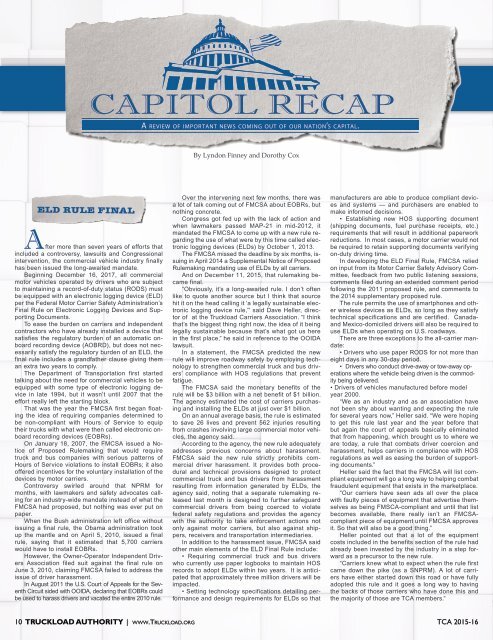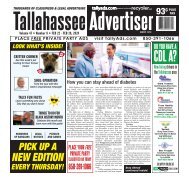Truckload Authority - Winter 2015-16
Count down our list of the top 10 trucking stories of 2015 and get all the details on the $305 billion Fixing America's Surface Transportation Act. Plus, we get the "dirty" truth from international TV star Mike Rowe.
Count down our list of the top 10 trucking stories of 2015 and get all the details on the $305 billion Fixing America's Surface Transportation Act. Plus, we get the "dirty" truth from international TV star Mike Rowe.
Create successful ePaper yourself
Turn your PDF publications into a flip-book with our unique Google optimized e-Paper software.
CapItol recap<br />
A review of important news coming out of our nation’s capital.<br />
By Lyndon Finney and Dorothy Cox<br />
ELD rule final<br />
A fter more than seven years of efforts that<br />
included a controversy, lawsuits and Congressional<br />
intervention, the commercial vehicle industry finally<br />
has been issued the long-awaited mandate.<br />
Beginning December <strong>16</strong>, 2017, all commercial<br />
motor vehicles operated by drivers who are subject<br />
to maintaining a record-of-duty status (RODS) must<br />
be equipped with an electronic logging device (ELD)<br />
per the Federal Motor Carrier Safety Administration’s<br />
Final Rule on Electronic Logging Devices and Supporting<br />
Documents.<br />
To ease the burden on carriers and independent<br />
contractors who have already installed a device that<br />
satisfies the regulatory burden of an automatic onboard<br />
recording device (AOBRD), but does not necessarily<br />
satisfy the regulatory burden of an ELD, the<br />
final rule includes a grandfather clause giving them<br />
an extra two years to comply.<br />
The Department of Transportation first started<br />
talking about the need for commercial vehicles to be<br />
equipped with some type of electronic logging device<br />
in late 1994, but it wasn’t until 2007 that the<br />
effort really left the starting block.<br />
That was the year the FMCSA first began floating<br />
the idea of requiring companies determined to<br />
be non-compliant with Hours of Service to equip<br />
their trucks with what were then called electronic onboard<br />
recording devices (EOBRs).<br />
On January 18, 2007, the FMCSA issued a Notice<br />
of Proposed Rulemaking that would require<br />
truck and bus companies with serious patterns of<br />
Hours of Service violations to install EOBRs; it also<br />
offered incentives for the voluntary installation of the<br />
devices by motor carriers.<br />
Controversy swirled around that NPRM for<br />
months, with lawmakers and safety advocates calling<br />
for an industry-wide mandate instead of what the<br />
FMCSA had proposed, but nothing was ever put on<br />
paper.<br />
When the Bush administration left office without<br />
issuing a final rule, the Obama administration took<br />
up the mantle and on April 5, 2010, issued a final<br />
rule, saying that it estimated that 5,700 carriers<br />
would have to install EOBRs.<br />
However, the Owner-Operator Independent Drivers<br />
Association filed suit against the final rule on<br />
June 3, 2010, claiming FMCSA failed to address the<br />
issue of driver harassment.<br />
In August 2011 the U.S. Court of Appeals for the Seventh<br />
Circuit sided with OOIDA, declaring that EOBRs could<br />
be used to harass drivers and vacated the entire 2010 rule.<br />
Over the intervening next few months, there was<br />
a lot of talk coming out of FMCSA about EOBRs, but<br />
nothing concrete.<br />
Congress got fed up with the lack of action and<br />
when lawmakers passed MAP-21 in mid-2012, it<br />
mandated the FMCSA to come up with a new rule regarding<br />
the use of what were by this time called electronic<br />
logging devices (ELDs) by October 1, 2013.<br />
The FMCSA missed the deadline by six months, issuing<br />
in April 2014 a Supplemental Notice of Proposed<br />
Rulemaking mandating use of ELDs by all carriers.<br />
And on December 11, <strong>2015</strong>, that rulemaking became<br />
final.<br />
“Obviously, it’s a long-awaited rule. I don’t often<br />
like to quote another source but I think that source<br />
hit it on the head calling it ‘a legally sustainable electronic<br />
logging device rule,’” said Dave Heller, director<br />
of at the <strong>Truckload</strong> Carriers Association. “I think<br />
that’s the biggest thing right now, the idea of it being<br />
legally sustainable because that’s what got us here<br />
in the first place,” he said in reference to the OOIDA<br />
lawsuit.<br />
In a statement, the FMCSA predicted the new<br />
rule will improve roadway safety by employing technology<br />
to strengthen commercial truck and bus drivers’<br />
compliance with HOS regulations that prevent<br />
fatigue.<br />
The FMCSA said the monetary benefits of the<br />
rule will be $3 billion with a net benefit of $1 billion.<br />
The agency estimated the cost of carriers purchasing<br />
and installing the ELDs at just over $1 billion.<br />
On an annual average basis, the rule is estimated<br />
to save 26 lives and prevent 562 injuries resulting<br />
from crashes involving large commercial motor vehicles,<br />
the agency said.<br />
According to the agency, the new rule adequately<br />
addresses previous concerns about harassment.<br />
FMCSA said the new rule strictly prohibits commercial<br />
driver harassment. It provides both procedural<br />
and technical provisions designed to protect<br />
commercial truck and bus drivers from harassment<br />
resulting from information generated by ELDs, the<br />
agency said, noting that a separate rulemaking released<br />
last month is designed to further safeguard<br />
commercial drivers from being coerced to violate<br />
federal safety regulations and provides the agency<br />
with the authority to take enforcement actions not<br />
only against motor carriers, but also against shippers,<br />
receivers and transportation intermediaries.<br />
In addition to the harassment issue, FMCSA said<br />
other main elements of the ELD Final Rule include:<br />
• Requiring commercial truck and bus drivers<br />
who currently use paper logbooks to maintain HOS<br />
records to adopt ELDs within two years. It is anticipated<br />
that approximately three million drivers will be<br />
impacted.<br />
• Setting technology specifications detailing performance<br />
and design requirements for ELDs so that<br />
manufacturers are able to produce compliant devices<br />
and systems — and purchasers are enabled to<br />
make informed decisions.<br />
• Establishing new HOS supporting document<br />
(shipping documents, fuel purchase receipts, etc.)<br />
requirements that will result in additional paperwork<br />
reductions. In most cases, a motor carrier would not<br />
be required to retain supporting documents verifying<br />
on-duty driving time.<br />
In developing the ELD Final Rule, FMCSA relied<br />
on input from its Motor Carrier Safety Advisory Committee,<br />
feedback from two public listening sessions,<br />
comments filed during an extended comment period<br />
following the 2011 proposed rule, and comments to<br />
the 2014 supplementary proposed rule.<br />
The rule permits the use of smartphones and other<br />
wireless devices as ELDs, so long as they satisfy<br />
technical specifications and are certified. Canadaand<br />
Mexico-domiciled drivers will also be required to<br />
use ELDs when operating on U.S. roadways.<br />
There are three exceptions to the all-carrier mandate:<br />
• Drivers who use paper RODS for not more than<br />
eight days in any 30-day period.<br />
• Drivers who conduct drive-away or tow-away operations<br />
where the vehicle being driven is the commodity<br />
being delivered.<br />
• Drivers of vehicles manufactured before model<br />
year 2000.<br />
“We as an industry and as an association have<br />
not been shy about wanting and expecting the rule<br />
for several years now,” Heller said. “We were hoping<br />
to get this rule last year and the year before that<br />
but again the court of appeals basically eliminated<br />
that from happening, which brought us to where we<br />
are today, a rule that combats driver coercion and<br />
harassment, helps carriers in compliance with HOS<br />
regulations as well as easing the burden of supporting<br />
documents.”<br />
Heller said the fact that the FMCSA will list compliant<br />
equipment will go a long way to helping combat<br />
fraudulent equipment that exists in the marketplace.<br />
“Our carriers have seen ads all over the place<br />
with faulty pieces of equipment that advertise themselves<br />
as being FMSCA-compliant and until that list<br />
becomes available, there really isn’t an FMCSAcompliant<br />
piece of equipment until FMCSA approves<br />
it. So that will also be a good thing.”<br />
Heller pointed out that a lot of the equipment<br />
costs included in the benefits section of the rule had<br />
already been invested by the industry in a step forward<br />
as a precursor to the new rule.<br />
“Carriers knew what to expect when the rule first<br />
came down the pike (as a SNPRM). A lot of carriers<br />
have either started down this road or have fully<br />
adopted this rule and it goes a long way to having<br />
the backs of those carriers who have done this and<br />
the majority of those are TCA members.”<br />
10 <strong>Truckload</strong> <strong>Authority</strong> | www.<strong>Truckload</strong>.org TCA <strong>2015</strong>-<strong>16</strong> T

















